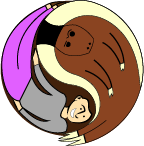The Short of It:
You cannot see Tao, but it’s everywhere.

14. the praise of the abyss.
What you cannot see by looking at it, is called plainness. What you cannot hear by listening to it, is called rareness. What you cannot get by grasping it, is called minuteness.
These three cannot be examined, and therefore they blend into Unity. Above it is not bright, below it is not obscure. Boundless in its operation, it cannot be named. Returning, it goes home into nothing. This I call the appearance of non-appearance, the form of nothing. This is what baffles investigation. Would you go before it, you cannot see its face. Would you go behind it, you cannot see its back. But to have such an apprehension of the Tau which was from of old as to regulate present things, and to know their beginning in the past; this I call having the clue of Tau.
14. ‘The Manifestation of the Mystery.’
14.1 We look at it, and we do not see it, and we name it ‘the Equable.’ We listen to it, and we do not hear it, and we name it ‘the Inaudible.’ We try to grasp it, and do not get hold of it, and we name it ‘the Subtle.’ With these three qualities, it cannot be made the subject of description; and hence we blend them together and obtain The One.
14.2 Its upper part is not bright, and its lower part is not obscure. Ceaseless in its action, it yet cannot be named, and then it again returns and becomes nothing. This is called the Form of the Formless, and the Semblance of the Invisible; this is called the Fleeting and Indeterminable.
14.3 We meet it and do not see its Front; we follow it, and do not see its Back. When we can lay hold of the Tao of old to direct the things of the present day, and are able to know it as it was of old in the beginning, this is called (unwinding) the clue of Tao.
14. praising the mysterious.
14.1 We look at Reason and do not see it; its name is Colorless. We listen to Reason and do not hear it; its name is Soundless. We grope for Reason and do not grasp it; its name is Bodiless.
14.2 These three things cannot further be analyzed. Thus they are combined and conceived as a unity which on its surface is not clear and in its depth not obscure.
14.3 Forever and aye Reason remains unnamable, and again and again it returns home to non-existence.
14.4 This is called the form of the formless, the image of the imageless. This is called the transcendentally abstruse.
14.5 In front its beginning is not seen. In the rear its end is not seen.
14.6 By holding fast to the Reason of the ancients, the present is mastered and the origin of the past understood. This is called Reason’s clue.

The Long of It:
Tao is not a thing you can see, hear, or touch, but evidence of it is everywhere. Pregnant with possibility, it gives rise to things, and then quickly dissolves back into nothingness. Want proof? You are it.
Only by applying these “formless forms” and by working with the intangible aspects of the Universe did we craft what we see before us today. Investigation is futile.
By combining the unknown possibilities of the present with the knowable impossibilities of the past, can we understand the power of what Roger Ames coins “cosmic way-making” (Ames 97).
-TB
